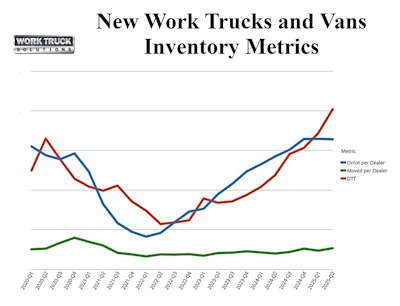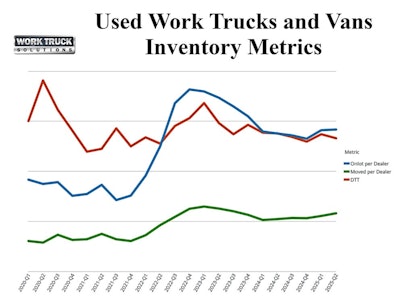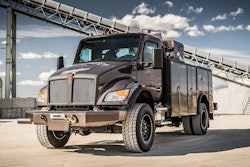Work Truck Solutions recently released its Q2 2025 Commercial Vehicle Market Analysis.
The company states the report uncovers continued strength in the work truck new commercial vehicle market and its ripple effects across the used sector. With inventory level stabilization, Work Truck Solutions says the commercial vehicle ecosystem is showing signs of healthy alignment.
In Q2, the company reports new vehicle pricing continued its gradual rise, with the average final price increasing by 0.4% quarter over quarter and 0.3% year over year to $59,842. On-lot inventory per dealer dipped slightly from Q1 (down 0.6%) but remains significantly higher year-over-year (up 14.7%), Work Truck Solutions says.

Additionally, sales activity picked up, with units moved per dealer rising 12.5% from Q1 and 35.0% year over year, reflecting operational demand, as well as a likely number of pull-ahead sales due to tariff concerns. Still, Days-to-Turn (DTT) rose again — up 17.4% from last quarter and 69.7% compared to Q2 2024 — revealing slower commercial vehicle inventory turns despite higher sales as pockets of inventory remain mismatched to their market demand.
“Although sales across most body types remain strong, the continued rise in new vehicle Days-to-Turn tells an important story,” says Aaron Johnson, CEO of Work Truck Solutions. “While not a slowdown, there are more vehicles on the lot, more choices for buyers, and more competition among commercial vehicle dealers.”
Work Truck Solutions recently released its Q2 2025 Commercial Vehicle Market Analysis.
The company states the report uncovers continued strength in the work truck new commercial vehicle market and its ripple effects across the used sector. With inventory level stabilization, Work Truck Solutions says the commercial vehicle ecosystem is showing signs of healthy alignment.
In Q2, the company reports new vehicle pricing continued its gradual rise, with the average final price increasing by 0.4% quarter over quarter and 0.3% year over year to $59,842. On-lot inventory per dealer dipped slightly from Q1 (down 0.6%) but remains significantly higher year-over-year (up 14.7%), Work Truck Solutions says.

Additionally, sales activity picked up, with units moved per dealer rising 12.5% from Q1 and 35.0% year over year, reflecting operational demand, as well as a likely number of pull-ahead sales due to tariff concerns. Still, Days-to-Turn (DTT) rose again — up 17.4% from last quarter and 69.7% compared to Q2 2024 — revealing slower commercial vehicle inventory turns despite higher sales as pockets of inventory remain mismatched to their market demand.
“Although sales across most body types remain strong, the continued rise in new vehicle Days-to-Turn tells an important story,” says Aaron Johnson, CEO of Work Truck Solutions. “While not a slowdown, there are more vehicles on the lot, more choices for buyers, and more competition among commercial vehicle dealers.”
[RELATED: If Trump EPA ditches GHG regs, will truck sales improve?]
As for the used space, the company adds used vehicle pricing continued to soften, falling 1.7% from Q1 and 2.9% year over year to an average final price of $34,456. Used inventory per dealer remained nearly flat compared to the first quarter of the year, after dipping in the final two quarters of 2024, while sales ticked upward by 4.5% quarter over quarter and 10.5% year over year. Despite an anomalous uptick in Q1 2025, DTT, as expected, continued to decline overall, dropping 5.6% YoY, the company says.

Median mileage of used commercial trucks and vans dropped 10.8% from the first quarter, but is still up 5.1% year over year. The quarterly drop in mileage is likely a result of more businesses trading in fleet vehicles in general, and doing so earlier than during the “pandemic era” when on-lot inventories were dramatically impacted by supply challenges.
In the alternative power sectors, Work Truck Solutions add new commercial battery electric and hybrid vehicle (BEV/HEV) pricing saw a substantial uptick, with new prices rising 1.8% QoQ and 19.1% year over year to an average of $57,513. Conversely, used commercial vehicle prices in this segment fell 0.64% QoQ and 3.7% year over year.
As more alternative fuel vehicles come into the market, Work Truck Solutions states it will offer further insights into the commercial BEV/HEV sector.
Johnson adds “The landscape is shifting. Success [for dealers] will hinge on how well they differentiate and adapt — whether through pricing strategies, inventory mix, digital merchandising, or more likely, a combination of all of these. The same tools that helped dealers thrive during leaner inventory times are at least as essential, if not more so, in an environment of increased competition. Visibility, agility and customer engagement aren’t just advantages — they’re requirements.”
As for the used space, the company adds used vehicle pricing continued to soften, falling 1.7% from Q1 and 2.9% year over year to an average final price of $34,456. Used inventory per dealer remained nearly flat compared to the first quarter of the year, after dipping in the final two quarters of 2024, while sales ticked upward by 4.5% quarter over quarter and 10.5% year over year. Despite an anomalous uptick in Q1 2025, DTT, as expected, continued to decline overall, dropping 5.6% YoY, the company says.

Median mileage of used commercial trucks and vans dropped 10.8% from the first quarter, but is still up 5.1% year over year. The quarterly drop in mileage is likely a result of more businesses trading in fleet vehicles in general, and doing so earlier than during the “pandemic era” when on-lot inventories were dramatically impacted by supply challenges.
In the alternative power sectors, Work Truck Solutions add new commercial battery electric and hybrid vehicle (BEV/HEV) pricing saw a substantial uptick, with new prices rising 1.8% QoQ and 19.1% year over year to an average of $57,513. Conversely, used commercial vehicle prices in this segment fell 0.64% QoQ and 3.7% year over year.
As more alternative fuel vehicles come into the market, Work Truck Solutions states it will offer further insights into the commercial BEV/HEV sector.
Johnson adds “The landscape is shifting. Success [for dealers] will hinge on how well they differentiate and adapt — whether through pricing strategies, inventory mix, digital merchandising, or more likely, a combination of all of these. The same tools that helped dealers thrive during leaner inventory times are at least as essential, if not more so, in an environment of increased competition. Visibility, agility and customer engagement aren’t just advantages — they’re requirements.”










